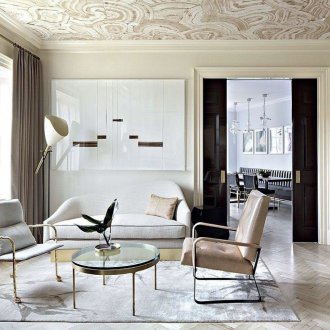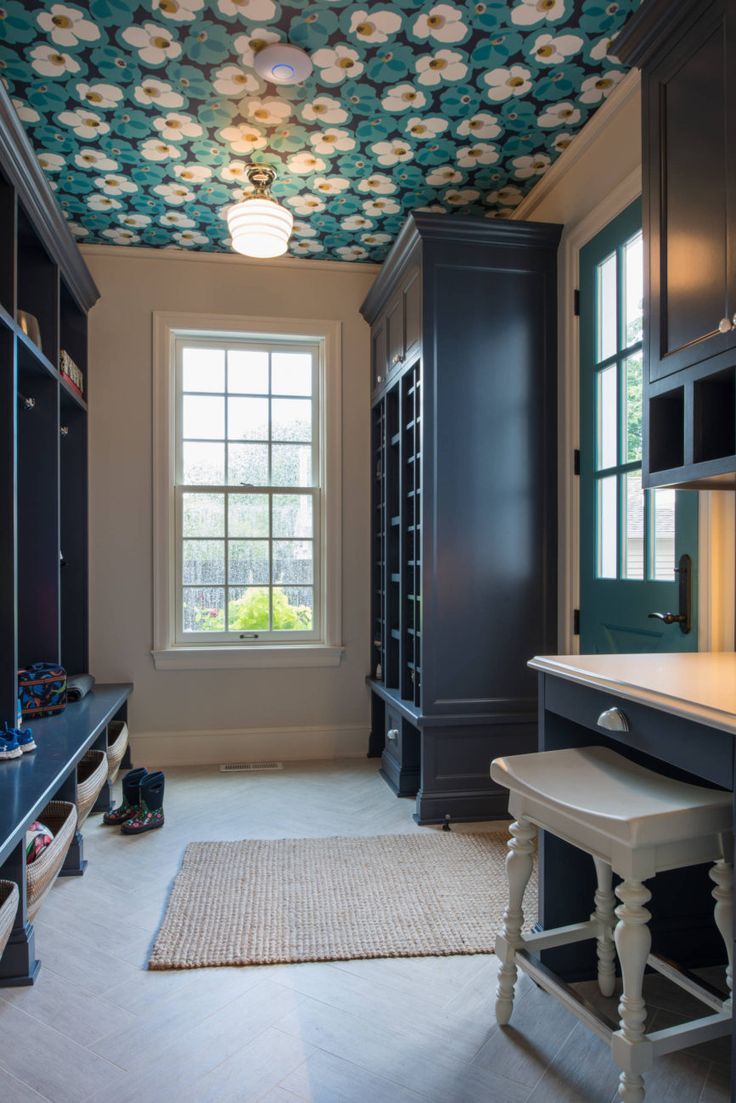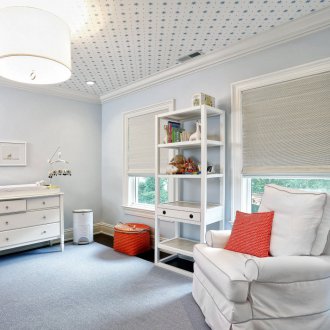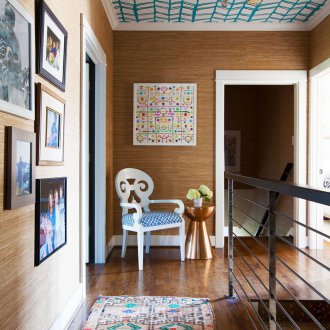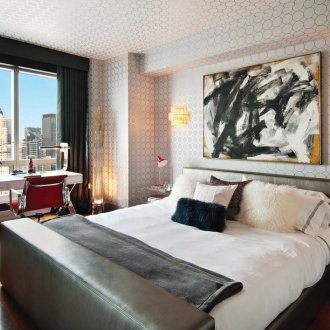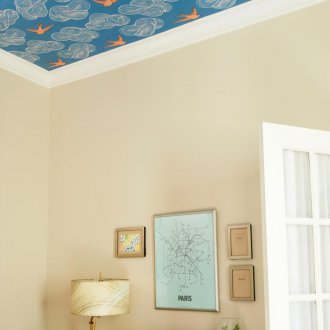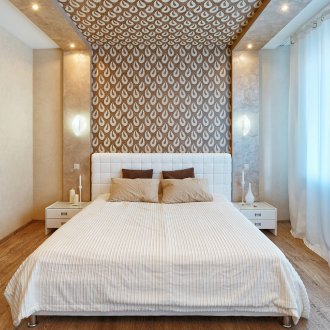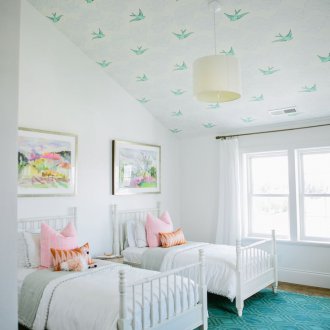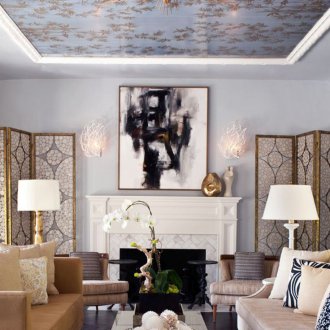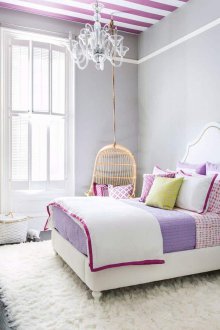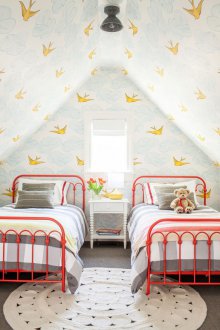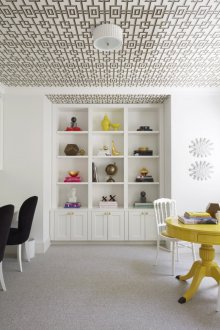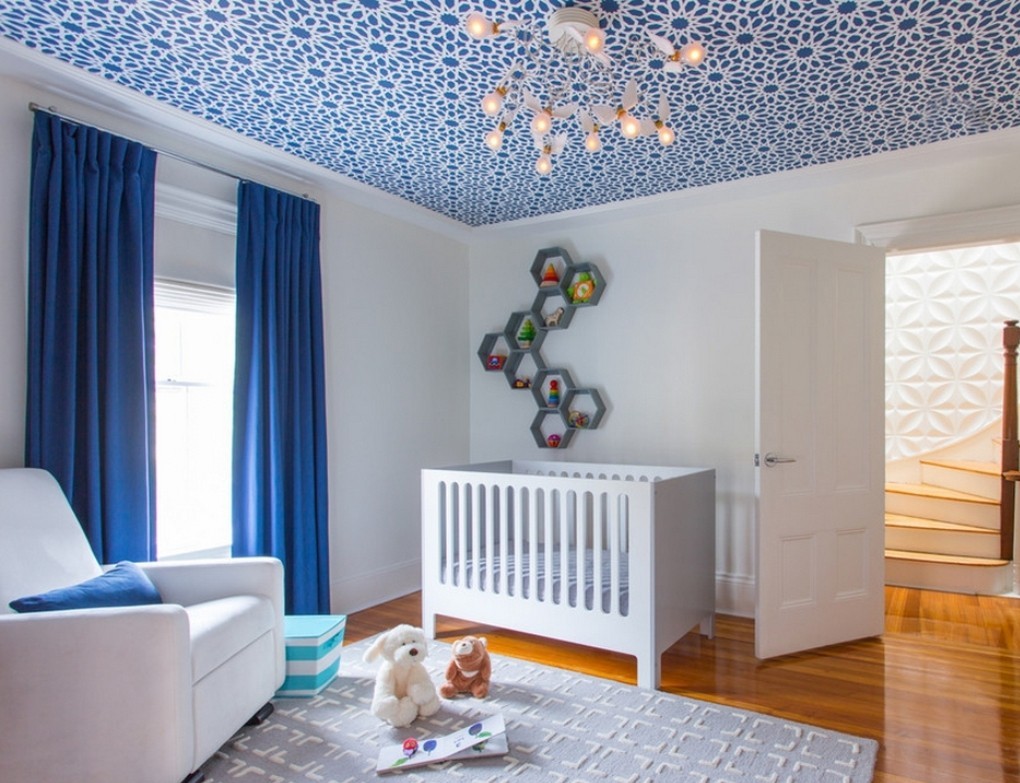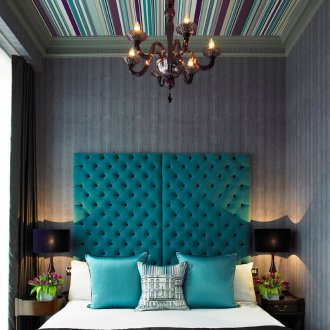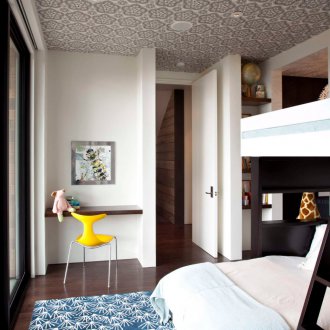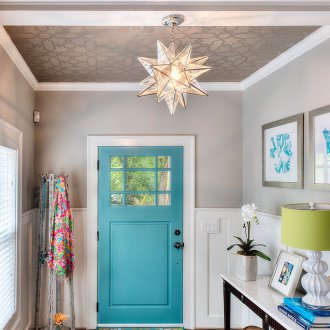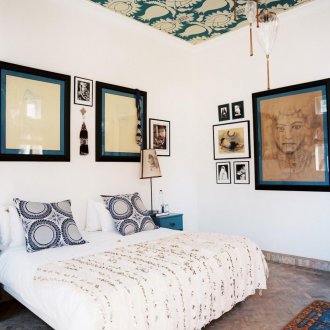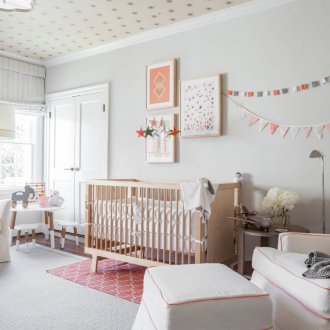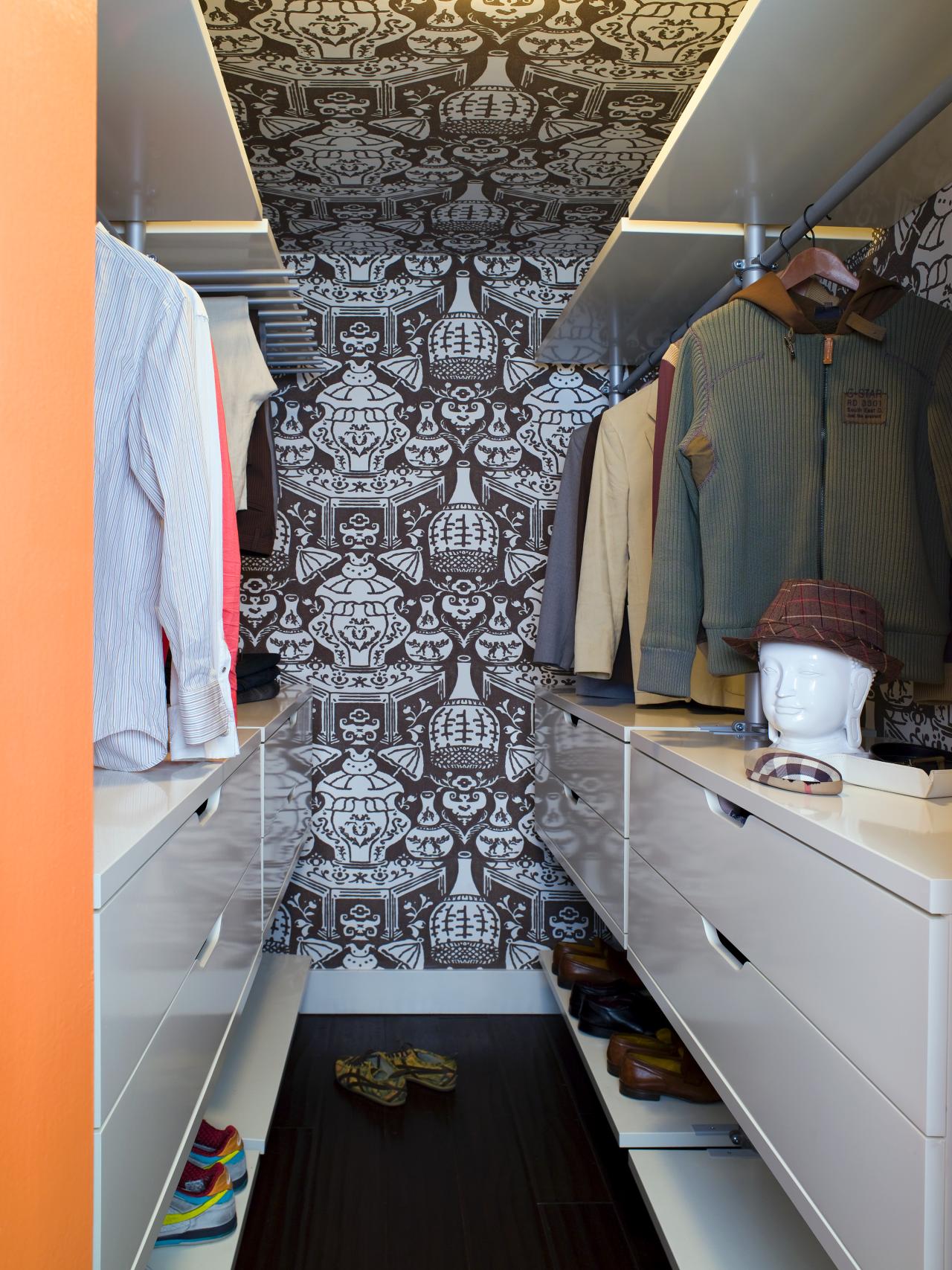Wallpaper on the ceiling: how to choose the perfect finishing material (23 photos)
Content
Sticking wallpaper on the ceiling is a hot issue for many people. Today, there is simply a huge amount of finishing materials and building techniques that could quickly and fairly qualitatively resolve issues with the refinement of ceilings.
However, people are still inclined to choose trellises as the base finish. Today, ceilings can be made with a variety of materials; options, how to arrange work surfaces, mass. Consider the main ones, based on what types of ceiling wallpaper exist.
Advantages of ceiling wallpaper
Paper ceiling wallpapers are considered one of the most cost-effective finishing materials, even taking into account the most progressive innovative finishing techniques. Everyone can stick wallpaper on the ceiling. The lesson, although it takes a lot of time, and also requires a lot of effort, still the majority succeeds in applying a new finish with their own hands, without the help of specialists.
Repair work of any profile is always scary because after the design of the room there is a lot of dust and debris. Wallpapering the ceilings avoids these unpleasant nuances. Cleaning after gluing surfaces with tapestries takes a minimum of time.
Properly selected ceiling wallpaper in the interior looks appropriate and quite impressive. Canvas trellis does not remove the height of the ceilings in the room, which is ideal for miniature rooms.
Depending on the type of source material and the quality of the finish, the glued ceiling can look great from 5 to 15 years. In fact, no other type of finishing materials can please with such an impressive operational period.
A wide range of products of this profile allows you to make any interior transformations: glue the base, and then paint the wallpaper on the ceiling, create neutral compositions or originally decorate surfaces with an unusual pattern. You can use silk plaster, decorate with various auxiliary elements (from stucco molding to fluorescent stickers), and also make many other interesting experiments.
Important Nuances
However, do not idealize this type of decoration materials. It is worth being prepared for the fact that you will have to face a number of difficulties. Before you glue the wallpaper on the ceiling, you need to prepare the work surfaces well.
Ceiling decoration always takes more time and effort than working with walls in the room. No matter how filigree the work of people gluing canvases is, there is always the danger of unnecessarily coarse “seams”. In some situations this is not permissible. For example, if you create a ceiling "starry sky."
Professional builders know several secrets that make it easier to apply wallpaper on the ceiling, as well as avoid the appearance of unnecessarily noticeable “seams”. For example, paper tapestries are best glued with an overlap from the main light source. Vinyl and non-woven wallpaper for the ceiling as clearly connect and align.
Painting wallpaper can also disappoint. The first rays of sunset can “declassify” all the mistakes of builders: the smallest defects will be noticeable on the surface of the ceilings.Unpainted areas are especially striking.
Paper wallpaper
Patterned wallpaper is the most common, inexpensive material. Such a design option will retain freshness and neatness up to 5 - 7 years. This is not the longest period of operation, but given the low cost of materials, it is quite decent.
Considering which wallpaper is suitable for apartments, it is necessary to take into account the main features of the premises where the lining will be glued. The ceiling in the country can be decorated with simple smooth paintings.
For a respectable living room, it is better to choose trellises with a rich shade and embossment. Wallpaper on the ceiling in the kitchen is recommended to be purchased from moisture-resistant materials that can be washed, so budget paper options are not always appropriate.
Important Nuances
Sticking wallpaper on the ceiling (even the simplest and most comfortable to use) can still disappoint. Paper webs are always abundantly lubricated with glue along the entire web. This makes the finishing process exhausting and routine.
Paper is afraid of moisture in any form. Paste paper trellises in the kitchen, where they are constantly cooked, in the bathroom, bathroom or on the balcony will be a gross mistake. It is better to choose a wallpaper of a neutral, non-marking color, since the paper lends itself only to dry cleaning, and it accumulates dust very quickly. White trellis will be the most impractical solution and will quickly lose their respectable appearance.
Textile wallpaper
Using textiles to decorate the ceilings allows you to create an exclusive interior, giving it a special cosiness and uniqueness, as well as improve the acoustic parameters of the room.
The following types are distinguished:
- Linen. The manufacturer applies whole fiber fibers to the paper or treats the surface with a mixture of natural and artificial fibers. This type of decoration is ideal for eco interiors, apartments in the Scandinavian, marine, rustic style. Cloths can be freely applied to plasterboard ceiling and other specific surfaces. This is a good option to decorate the ceiling in the country, making the house a spectacular original interior, for example, in the ethnic direction. It is noteworthy that the rich texture of flax avoids the appearance of unaesthetic joints;
- Silk is a decorative finish made by applying silk fragments to the prepared canvas. Silk wallpaper on the ceiling is used for bedrooms, living rooms, children's rooms. The coating is distinguished by particularly pronounced aesthetic qualities. Wallpaper surfaces are smooth, glossy, with spectacular tints. Dust is attracted to this type of environmental materials much less than in the case of paper or linen trellises;
- Jute. The coating based on jute thread also has an interesting texture. Before you glue wallpaper on the ceiling, you must carefully study the technology of working with finishing materials. Trellis, as a rule, are massive, they allow you to hide possible flaws on the surface of a drywall or other canvas.
Many people know how to glue a fabric-based ceiling wallpaper, but few know how to eliminate air bubbles that appear from time to time on a work surface. Defects that are formed can easily be eliminated by ironing the surface with an iron heated at medium power.
Liquid wallpaper
Liquid wallpaper is presented in the form of a dry cellulose mixture, which is diluted with water and then applied to work surfaces. The novelty is of genuine interest, potential buyers always have a lot of questions: is it possible to use cellulose finish in children's rooms, is it suitable for the kitchen, how to glue “liquid” tapestries on a plasterboard ceiling, is it possible to further finish such surfaces (for example, attaching stickers, drawing on the ceiling and other decorating techniques).
How to decorate the ceiling, and look after the new finish is very simple.These are practical and ecological trellises that lend themselves well to cleaning, practically do not attract dust, look aesthetically pleasing, respectable, retaining their “pristine” freshness for a long time.
Cullet
Vinyl wallpapers on the ceiling are also used quite often. The material itself consists of two layers: polyvinyl chloride and paper (less commonly non-woven). Due to the specific surface coating, such tapestries are well tolerated by moisture. The thicker the layer of polyvinyl chloride, the greater the degree of resistance of the finish to moisture.
The following types are distinguished:
- Foam-free vinyl. The convex texture allows you to hide small defects on the surface. Before decorating the ceiling, the trellises are carefully selected taking into account the design concept and the general style of the room;
- Wallpaper vinyl hot stamping. Such tapestries can be glued in any room with a complex interior. The applied drawing looks very impressive and believable. Often vinyl is decorated "like natural stones", give the effect of textured plaster or even metals;
- Screen printing. Flat vinyl allows you to wallpaper the ceiling with a delicate glossy texture, and noble walls in any type of room. This type of trellis is acceptable for working exclusively with perfectly smooth surfaces;
- Chemical embossed wallpaper. Finishing is not afraid of "chemistry", stably tolerates the "aggression" of ultraviolet radiation.
Vinyl is easy to care for. You can even clean surfaces with liquid household cleaning products. Pasting the ceiling with wallpaper for painting can be done with vinyl wallpaper. Moreover, you can change the color of the canvas on the basis of the same coating several times (it all depends on the quality of the trellis). Painting takes a little time, and the effect is always pleasing.
Non-woven
Without even knowing how to glue the non-woven wallpaper on the ceiling, most potential buyers consider this particular type of trellis as the ideal type of finish. There are enough reasons for this.
The surface is treated with glue only at the attachment point, and not over the entire canvas. This allows you to freely move fragments of trellis in the right direction, forming the most even and high-quality coating.
Flizelin is safe, does not contain potentially harmful substances. The material can be either painted or decorated in various ways. This is a good durable option for landscaping a child’s room.
Wallpaper for painting
Considering painting as one of the possible ways to decorate surfaces, it is worth considering a separate category of trellis. This refers to special wallpaper for painting on the ceiling.
The following types of materials can be used:
- Flizelin (painting is possible only those species that were originally positioned by the manufacturer as suitable for staining);
- Vinyl (the painted surface of foamed vinyl looks best);
- Cullets (to obtain the desired texture use water-based paints or latex analogues).
Before gluing the wallpaper for painting on the ceiling, it is necessary to analyze the features of the interior. Not always painted surfaces blend well with key design components. For example, eco-style involves the use of exclusively natural materials with the appropriate texture.
Fiberglass
Before you stick wallpaper on the ceiling of traditional paper or already bored vinyl, you should pay special attention to conceptually new types of finishes. Fiberglass is recommended primarily for use in the kitchen.
For production use glass. The material is heated, the thinnest filaments are formed, which are then woven into the thinnest web. Fiberglass (like fiberglass) have many advantages:
Asking the question of how to make the ceiling strong and aesthetically attractive at the same time, it is worth choosing wall-paper;
- Fiberglass can be painted or left in its original form;
- Long term of operation;
- Natural material that does not contain harmful impurities;
- It is well cleaned;
- It is not exposed to biological attacks (mold, fungus).
However, fiberglass, like any other material, has its own specific features. Wallpaper of this type are quite expensive. If necessary, the trellis canvas is very difficult to separate from the ceiling or walls. On the one hand, this is very good, but on the other, it provokes a number of difficulties.
Gluing wallpaper for painting on the ceiling can only be butt. The canvases themselves are quite thick, so overlapping will lead to the fact that the formed seams will be very noticeable.
In general, it will not be difficult to choose the perfect trellis for each particular room, given the smallest features and wishes of the apartment owners. For price, design and performance, you can always find an option that is extremely consistent with all requirements.
